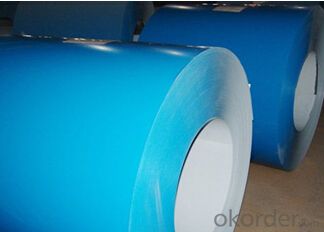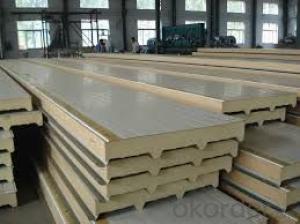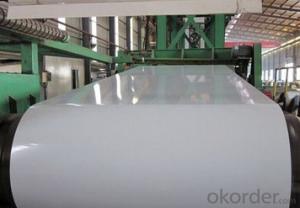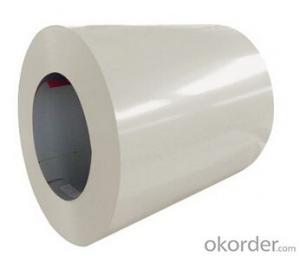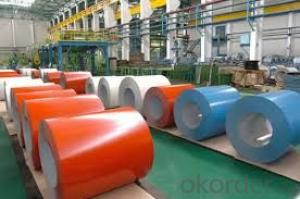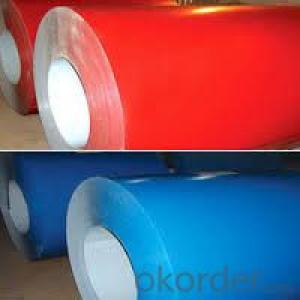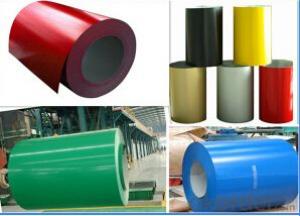Desinged Prepainted Galvanized Steel Coil (PPGI/PPGL)
- Loading Port:
- Tianjin
- Payment Terms:
- TT OR LC
- Min Order Qty:
- 25 m.t.
- Supply Capability:
- 10000 m.t./month
OKorder Service Pledge
OKorder Financial Service
You Might Also Like
Product Description
Model NO.:600-1250mm, OEM avilable
Surface Treatment:Galvanized
Certification:ISO, SGS
Technique:Cold Rolled
Standard:ASTM, JIS, AISI, DIN
Application:Container Plate
Edge:Slit edge
Stock:Stock
Steel Grade:Q235B
Thickness:0.12mm-3.0mm
Coil Weight:3-8 Tons
Gloss:65%-80%
Export Markets:Global
ID:508mm
Zinc Coating:50g-250g/Psm
Feedback:Within 24 Hours
Additional Info.
Packing:Export Standard Package or as Request
Standard:AISI, ASTM, BS, DIN, GB, JIS
Origin:China
HS Code:7210701000
Production Capacity:150, 000tons/Year
Specifications:
1. Thickness: 0.12mm-1.3mm
2. Width: 600mm-1250mm
3. Length: According to client's demands
4. Top paint: 15 to 25 um (5 um + 12-20 um)
Back paint: 7 +/- 2 um
5. Gloss: Normal or High gloss
6. Zinc coating: Z50-Z275G/psm
7. Inside Diameter: 508mm/610mm
8. Outside Diameter: 1000mm-1500mm
9. Coil weight: 3-8 tons
10. Payment: T/T, L/C, D/P, Paypal, Western Union
11. Trade Term: FOB, CFR, CIF
12. MOQ: 25 Mt
13. Package: Export standard package or as request
14. Shipment: By container
15. Standard: AISI, ASTM, BS, DIN, GB, JIS
16. Grade: JIS G3322, CGLCC, ASTM A755, CS-B
FAQ
1.What's your MOQ?
25MT, it is for one container.
2.Do you have QC teams?
Yeah, sure, our QC team is very important, they will keep the quality control for our products.
3. What's your normal delivery time?
Our delivery time about 10-20days for standard sizes, if you have other requirements like hardness and width ,it is about 20-40days. But don't worry ,we also try our best for the delivery time ,because time longer and our cost is higher.
4.Are the products tested before shipping?
Yes, all of our PPGI and GI was qualified before shipping. We test every batch every day
- Q: I'm trying to bend stainless steel spoons, forks knives etc. for an art project. Will heating them help bend them into certain shapes or will heat only strengthen it? What is the best way to bend stainless steel?
- Hope this helps!
- Q: What are the different types of steel coil coatings for corrosion resistance?
- Steel coil coatings can be classified into two main types: organic coatings and metallic coatings. 1. Organic coatings are commonly used for steel coil applications due to their excellent corrosion resistance and durability. There are four types of organic coatings: - Polyester coatings: These coatings offer good weatherability and resistance to chemicals, making them suitable for outdoor applications. - PVDF coatings: These coatings are highly resistant to UV radiation, weathering, and chemicals. They provide exceptional durability and are often used in demanding environments such as coastal areas or industrial settings. - Polyurethane coatings: These coatings offer excellent abrasion resistance and a high level of corrosion protection. They are commonly used in applications where there is a higher risk of mechanical damage or exposure to harsh conditions. - Epoxy coatings: These coatings provide excellent adhesion and chemical resistance. They are often used in industrial applications where resistance to chemicals, solvents, and oils is required. 2. Metallic coatings provide effective corrosion protection and can be further divided into two types: - Galvanized coatings: These coatings involve applying a layer of zinc to the steel surface through a hot-dip or electroplating process. This creates a barrier between the steel and the surrounding environment, providing effective corrosion protection. Galvanized coatings are widely used in various industries due to their cost-effectiveness and good durability. - Galvannealed coatings: These coatings are similar to galvanized coatings but undergo an additional heat treatment process. This results in a coating with increased hardness and improved paint adhesion, making it suitable for applications that require additional surface protection or paintability. When selecting the appropriate steel coil coating, it is essential to consider the specific requirements of the application and the level of corrosion resistance needed. Consulting with coating manufacturers or industry experts can help determine the most suitable coating for a particular application.
- Q: What are the advantages of using galvanized steel coils?
- There are numerous advantages to using galvanized steel coils in various applications. Firstly, galvanized steel coils are highly resistant to corrosion. The process of galvanization involves coating the steel with a layer of zinc, which acts as a protective barrier against moisture, chemicals, and other elements that can cause rust and corrosion. This makes galvanized steel coils ideal for outdoor applications where they will be exposed to harsh weather conditions or corrosive substances. Secondly, galvanized steel coils have excellent durability and longevity. The zinc coating provides an extra layer of protection to the steel, making it more resistant to wear and tear. This means that galvanized steel coils have a longer lifespan compared to other types of steel, reducing the need for frequent replacements and saving costs in the long run. Additionally, galvanized steel coils have high strength and structural integrity. The zinc coating not only provides corrosion resistance but also enhances the overall strength of the steel. This makes galvanized steel coils suitable for applications that require a strong and reliable material, such as construction, automotive, and industrial manufacturing. Furthermore, galvanized steel coils are easy to work with and require minimal maintenance. The zinc coating provides a smooth and uniform surface, making it easier to paint, weld, and fabricate. Unlike other coatings or finishes, galvanized steel coils do not require regular maintenance or additional protective measures, reducing the time and effort needed to keep them in good condition. Lastly, galvanized steel coils are environmentally friendly. The zinc coating used in galvanization is a recyclable material, making it a sustainable choice for various industries. Additionally, the long lifespan of galvanized steel coils reduces the need for frequent replacements, reducing waste and the overall environmental impact. In conclusion, the advantages of using galvanized steel coils include corrosion resistance, durability, high strength, easy workability, low maintenance, and environmental sustainability. These benefits make galvanized steel coils a popular choice in a wide range of applications, from construction and manufacturing to automotive and infrastructure projects.
- Q: What are the common defects in steel coils?
- Some common defects in steel coils include surface defects like scratches, rust, and pits, as well as internal defects like cracks, laminations, and non-uniform thickness. Other defects may include coil set, which is a curvature in the coil, and edge wave, which is a distortion along the edges of the coil.
- Q: How are steel coils used in the construction industry?
- Steel coils are commonly used in the construction industry for various purposes such as manufacturing structural components, reinforcing concrete structures, and creating durable roofing and siding materials. These coils are unraveled and cut into specific sizes to meet the project requirements, ensuring strength, stability, and longevity in construction applications.
- Q: What are the commonly used molds steel?
- Usually a hot working grade ( H series ) tool steel is used in die cast mold detail tooling. We typically use H-13 for our applications but have substituted with D-2 on occasion.
- Q: How are steel coils used in the production of automotive suspension systems?
- Steel coils are used in the production of automotive suspension systems as they provide the necessary support and flexibility for the vehicle's suspension. These coils are typically used in the form of coil springs, which absorb shocks and vibrations from the road surface, ensuring a smooth and comfortable ride for the driver and passengers. The steel coils are designed to withstand the weight of the vehicle while maintaining their shape, allowing for proper suspension movement and control.
- Q: What are the dimensions of steel coils used in automotive part manufacturing?
- The dimensions of steel coils used in automotive part manufacturing can vary depending on the specific application and manufacturer. However, commonly used dimensions for steel coils in automotive part manufacturing range from 0.5 to 3 millimeters in thickness and 600 to 2000 millimeters in width. The length of the coils can also vary, typically ranging from several meters to several hundred meters. It is important to note that these dimensions are not fixed and can be customized to meet the specific requirements of each automotive part being manufactured.
- Q: How are steel coils inspected for flatness using optical sensors?
- The process of inspecting the flatness of steel coils involves the use of optical sensors, which are part of a system known as optical flatness measurement. This system employs high-resolution cameras to capture images of the steel surface as it passes through the inspection line. To begin, the steel coil is unwound and conveyed over a roller table. While in motion, the optical sensors are positioned above the coil to capture images at regular intervals. These sensors are typically a combination of laser line projectors and high-resolution cameras. The laser line projectors emit a thin, straight line of laser light across the width of the steel coil. This laser line serves as a reference plane for measuring the flatness of the steel surface. Subsequently, the high-resolution cameras capture images of the laser line interacting with the steel coil. The captured images are then subjected to analysis using advanced image processing algorithms. These algorithms examine the deformation of the laser line on the steel surface and calculate the deviations from the flat reference plane. These deviations indicate any irregularities or variations in the flatness of the steel coil. The optical sensors possess the capability to accurately detect even the most minute deviations in flatness, measuring them in micrometers or smaller units. This enables manufacturers to identify and correct any flatness issues in the steel coils before further processing or shipment. In addition to measuring flatness, optical sensors can also identify other surface defects such as waviness, scratches, or dents. By incorporating multiple cameras and laser line projectors from different angles, a comprehensive inspection of the steel coil's surface can be achieved. Overall, the utilization of optical sensors for inspecting steel coil flatness offers a swift, precise, and non-contact method. By identifying and addressing any flatness issues early in the production process, manufacturers can guarantee the delivery of top-quality steel products to their customers.
- Q: Can steel coils be stacked on top of each other?
- Yes, steel coils can be stacked on top of each other.
Send your message to us
Desinged Prepainted Galvanized Steel Coil (PPGI/PPGL)
- Loading Port:
- Tianjin
- Payment Terms:
- TT OR LC
- Min Order Qty:
- 25 m.t.
- Supply Capability:
- 10000 m.t./month
OKorder Service Pledge
OKorder Financial Service
Similar products
Hot products
Hot Searches
Related keywords


